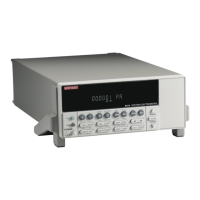Limit Tests 10-11
• LIN4MOD (Line 4 Mode):
ENDOFTST (End of Test) — With this mode, Model 6514 will pulse the EOT line
when the test is finished. Use with catagory register component handlers.
/BUSY and BUSY — Pulls line 4 LO (/Busy) or HI (Busy) while the test is in pro-
cess. Use with catagory pulse component handlers.
Arm layer configuration menu
When using a component handler, the “start of test” option is selected from the Arm-In menu
item of the arm layer configuration menu. To access the menu, press SHIFT and then CONF-
ARM.
• ARM-IN — Select the “start of test” option:
IMM (Immediate) — Test starts when LIMIT key is pressed.
TEST — Test starts when the handler pulls the SOT line of the Digital I/O high.
/STEST — Test starts when the handler pulls the SOT line of the Digital I/O low.
NOTE The other arm-in control sources are seldom used with component handlers, but are
available.
Perform limit tests
Step 1 Configure test system
As previously explained, testing the system could be as simple as connecting a DUT to Model
6514 or could employ the use of a component handler for binning operations.
Step 2 Configure measurement
Configure Model 6514 for the desired measurement as covered in the previous sections of this
manual.
Step 3 Configure limit tests
Configure Model 6514 for the limit tests as explained in “Limit Test Configuration”.
Step 4 Start testing process
To enable the limit tests, press the LIMIT key. If the SOT line of the Digital I/O port is being
used by a component handler, the test process will not start until the handler pulses the SOT line.
Otherwise, the testing process will start when LIMIT is pressed.
Step 5 Stop testing process
The testing process can be terminated at any time by again pressing the LIMIT key. When
using a component handler, the testing process will stop after the last DUT is tested.

